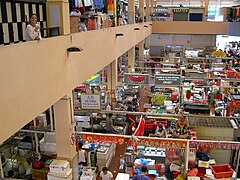Wet market
| Wet market | |||||||||||
|---|---|---|---|---|---|---|---|---|---|---|---|
 | |||||||||||
| Chinese | 街市 | ||||||||||
| Hanyu Pinyin | jiē shì | ||||||||||
| Jyutping | gaai1 si5 | ||||||||||
| Literal meaning | street market | ||||||||||
| |||||||||||
| Traditional markets | |||||||||||
| Traditional Chinese | 傳統市場 | ||||||||||
| Simplified Chinese | 传统市场 | ||||||||||
| |||||||||||

In Hong Kong English and Singapore English,[1] a wet market is a market selling fresh meat, fish, produce, and other perishable goods as distinguished from "dry markets" which sell durable goods such as fabric and electronics.[2]
Chinese wet markets
Wet markets were traditionally places that sold dead and live animals out in the open. This includes poultry, fish, reptiles, and pigs. However, since SARS, large animals and poultry are not as commonly found in the markets in Hong Kong, though live fish, shellfish, and frogs are widely available. Some markets also sell exotic animals.[3] Fresh fruits and vegetables are also available. Wet markets also generally include butcher shops with fresh meat. The fresh meat and fish sections are separate from the fruit and vegetable stalls. Many markets also have stalls that sell dried goods, flowers, and processed tofu as well as cooked meat.[4]
In Hong Kong wet markets are most frequented by older residents, those with lower incomes, and domestic helpers who serve approximately 10 percent of Hong Kong's residents.[4][5] Wet markets have become destinations for tourists to "see the real Hong Kong".[4][6]
Many of the wet market buildings are owned by property investment firms and as a result the price of food can vary from market to market.[7] In general, the owner of the wet market building is responsible for maintaining the building infrastructure. Stalls are rented out to retailers, who purchase and sell their goods independently. This is in contrast to a supermarket which is operated by a single company.
For some customers, it is important to see the animal alive before it is purchased to check its health and quality. This is generally not an option in supermarkets, except in lobster or fish booths. Most wet markets have facilities for allowing a customer to choose a live animal, then either take it home as is or have it killed and cleaned.
In culture
In September 2012, Hong Kong lifestyle retail store G.O.D. in cooperation with Sino Art, held The Street Market Symphony Exhibition at Olympian City 2, their first solo art exhibition in a shopping mall. The exhibition used multi-media installations housed in large red lampshades, the iconic representation of Hong Kong's wet markets. They are used to make the food look fresher.[8]
Hong Kong wet markets
In 1920, Reclamation Street Market launched. Due to structure problem, Reclamation Street Market was removed by the government in 1953.[9] In 1957, Yau Ma Tei Street Market launched to replace the Reclamation Street Market.[10] There were fixed-pitch stalls which sold vegetables, fruits, seafood, beef, pork, and poultry. Also, there were stalls selling baby chickens, baby ducks, and three-striped box turtle as pets.[11]
Central Market was launched on 16 May 1842. Its position was central, on Queen's Road. In this market, people could find all kinds of meat, fruit and vegetables, poultry, salt fish, fresh fish, weighing rooms and money changers. [12]
Hygiene
If sanitation standards are not maintained, wet markets can spread diseases. Because of the openness, newly introduced animals may come in direct contact with sales clerks, butchers, and customers. Insects such as flies have relatively easy access to the food products. Carcasses are sometimes thrown on the floor to be butchered. Both the current avian flu outbreak and SARS can be traced to keeping live animals in wet markets and its potential for contamination. In 2008 the government of Hong Kong proposed that all poultry should be slaughtered at central abattoirs to combat the spread of avian flu.[13] However, public opposition to the scheme led to its abandonment.
Gallery
-
Wet market, Singapore
-
Indoor markets are generally more organized than outdoors in Hong Kong
-
Live turtles next to pickled ginseng in Namdaemun Market, Seoul
-
Indoor markets also exist under shopping areas such as this one under Lok Fu Shopping Centre (Hong Kong).
See also
References
- ^ France-Presse, Agence (13 May 2016). "East Asian words make it into Oxford English Dictionary". The Guardian. London. Retrieved 22 May 2018.
- ^ Wholesale Markets: Planning and Design Manual (Fao Agricultural Services Bulletin) (No 90)
- ^ "Conservation (Environment), Wildlife (Environment), World news, China (News), Animal welfare (News), Food (impact of production on environment), Animals (News), Ethical and green living (Environment), Environment, Chinese food and drink, Asia Pacific (News)". The Guardian. London. 15 May 2009.
- ^ a b c "Wet Markets in Hong Kong". Wix.com. Retrieved 2016-08-01.
- ^ "EmeraldInsight". EmeraldInsight.com. Retrieved 2016-08-01.
- ^ Chong, Sei (18 March 2011). "A Guide to Hong Kong's Wet Markets". The New York Times. Retrieved 2016-08-01.
- ^ Elmer W. Cagape (2011-09-08). "Tung Chung town pays the most for food in Hong Kong". Asian Correspondent. Retrieved 2016-08-01.
- ^ 超巨街市燈現身商場 [Super large wet market red lamps appears in shopping mall]. Sharp Daily (in Chinese). 14 September 2012. Retrieved 19 November 2012.
- ^ 鮑紹霖 (2012). 《第二屆廿一世紀華人地區歷史教育論文集》. 中華書局(香港)有限公司. p. 332.
- ^ "油麻地新建街市昨晨開幕後營業". 香港工商日報. 1957-11-02. Retrieved 2019-03-04.
- ^ "Yau Ma Tei's wet markets in the early post-war period". 2011-03-29. Retrieved 2019-03-04.
- ^ "The Friend Of China, and Hong Kong Gazette" (PDF). 1842-05-12. Retrieved 2019-03-04.
- ^ "Central abattoir set for 2011". Archive.news.gov.hk. 2008-06-13. Retrieved 2016-08-01.




